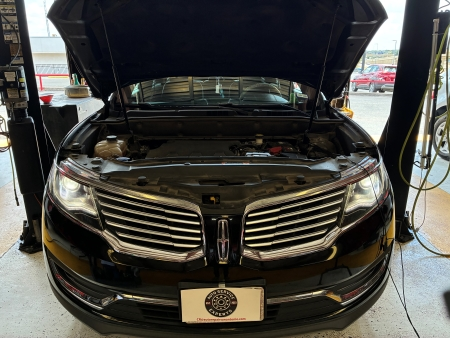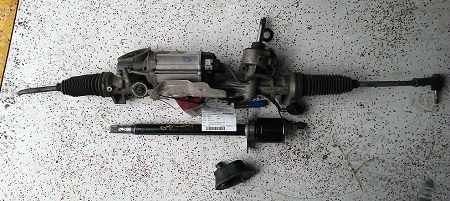Auto Suspension and Steering Repairs and Services, San Antonio
Steering & Suspension Repair by Auto Service Experts Mechanic Shop
For reliable suspension and steering repair in San Antonio, trust the ASE-certified mechanics at Auto Service Experts. With over 25 years of experience, our team has the expertise to handle everything from diagnosing complex electronic steering issues to upgrading suspension systems for improved performance. We take the time to accurately identify your vehicle’s needs and explain the best repair options, ensuring you enjoy maximum safety, control, and comfort every time you’re on the road.
Electronic Power Steering Diagnosis on 2017 Lincoln MKX

At Auto Service Experts, we specialize in diagnosing and repairing modern electronic steering systems. These photos document the recent diagnostic journey of a Lincoln MKX that came in with hard steering complaints. The initial scan revealed that the module was not communicating with the rest of the vehicle’s network. The diagnostic scanner displayed fault codes for lost communication. With loss of communication, the network does not recognize the module, preventing it from functioning. Together, the sequence of images illustrates the systematic steps technicians follow to move from initial symptoms to the precise root cause of a complex steering system failure.
Our ASE-certified technicians performed electronic testing to narrow down the cause of the issue. We inspected the vehicle’s electronic steering control module (the “black box” that manages steering signals) and verified that power and ground connections were reaching the unit. The scan tool confirmed these basics were intact, ruling out a simple wiring or power supply failure.


Together, the sequence of images illustrates the systematic steps technicians follow to move from initial symptoms to the precise root cause of a complex steering system failure. Through systematic testing, we confirmed that the issue was not in the wiring or external circuits, but due to an internal fault within the electronic steering rack module itself. This failure explained the hard steering the driver experienced.
Electronic steering systems are common in today’s vehicles, offering better efficiency and control. However, when problems occur, they require advanced diagnostic tools and technicians who specialize in automotive electrical system diagnostics. If you notice stiff steering, warning lights, or communication faults, our team has the training and equipment to find the root cause and get you safely back on the road.
Steering Column
A car steering system enables us to direct and maneuver our car or truck, making and recovering from turns at various speeds. These systems provide a mechanical advantage, reducing the effort required for the driver to rotate the steering wheel and turn the vehicle. They transfer the force a driver applies to the wheel along the steering column to a steering box.
Modern steering columns often feature a collapsible design to minimize the risk of serious driver injury in the event of a car crash. They usually incorporate switches for the vehicle ignition, lights, windshield wipers, and lock assembly. Some 4-wheel and electric-assisted systems also include sensors and control units to send data to the vehicle’s steering control modules.
Steering Box

Electronic Rack and Pinion Replacement
Rack and Pinion – the most common type of steering system, designed initially to maneuver lightweight sports cars at high speeds quickly. This system, however, requires a significant amount of operator effort at low speeds. The size of the pinion determines the reduction ratio. Smaller pinions are easier to turn than large pinions but require more rotations of the wheel to turn the vehicle.
Standard steering box designs include:
The steering box converts the wheel’s rotary movement into the wheels’ directional change.
Worm Gearbox – designed to be sturdy enough to reduce the steering effort needed to turn heavier loads, this system is more complicated and has more components than the rack and pinion design.
Types of worm gearboxes include:
• Worm and Sector
• Worm and Nut
• Worm and Roller
Recirculating Ball Steering Box – a very common steering design that combines worm and sector with worm and nut technology. This design may be manual or power-assisted.
Power Steering System Service and Repair
Power steering compensates for the additional weight on the vehicle’s front end, providing the driver with more effortless control and maneuverability, especially when slowly turning corners or parking. A hydraulic pump pressurizes fluid and pumps it through connecting hoses and lines to the power unit on either the rack and pinion or the steering box. It is essential to follow the manufacturer-recommended service schedule for power steering fluid replacement, as the fluid can become contaminated or depleted, potentially damaging the hoses and lines, which can lead to leaks and reduced steering performance. Allowing fluid to reach low levels can also lead to the need for a pump replacement.
Shocks and Struts Function and Wear
Vehicle suspension systems not only increase driver comfort, but also play an essential role in acceleration, steering, braking, performance, control, and ultimately driver safety. Replacing Shocks and Struts after 50,000 miles can restore your automobile’s performance, and upgrading them can improve handling and increase towing capacity.
Auto Suspension Systems
A vehicle suspension system is designed to maintain contact between its tires and the ground, thereby increasing driver comfort and safety. Front and rear springs support the vehicle’s weight and reduce the jarring impact as the vehicle encounters uneven ground surfaces. Shock absorbers work to further reduce the bouncing motion felt within the vehicle. A loose suspension increases the amount of effort required to stop the vehicle. This creates excess stress on the braking system, leading to the need for more frequent repairs or servicing of your vehicle’s brakes. It can also cause serious safety issues. Auto suspension systems help to protect vehicle components from unnecessarily rough operating conditions, therefore improving their lifetime and performance.
Automotive suspension and steering components that most commonly require repair:
- Alignment
- Struts
- Shocks
- Tie Rod Ends
- Sway Bar Links
- Pitman Arm
- Idler Arm
- Rack & Pinion
- Gear Box
- Electronic Steering
- Ball Joints
- Control Arms
- Wheel Bearings
- Torsion Bar
- Lift Kits
- Lowering Kits
- Radius Arms
